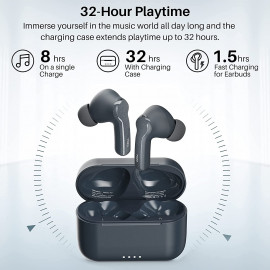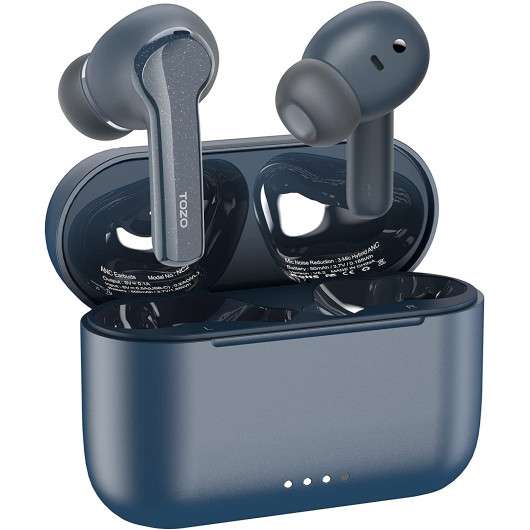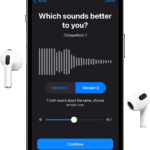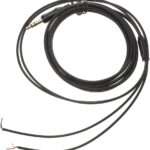In-Ear Monitors (IEMs) are devices used by musicians and audio engineers to listen to music or a mix of vocals and stage instrumentation directly within the ear canal.
They provide a clear, isolated sound and are an alternative to traditional floor wedges. In-ear monitors offer a personalized audio experience, especially useful for live performances and studio recording.
They fit snugly in the ear, providing both sound quality enhancement and a reduction in ambient noise. IEMs come in various forms, from universal fits to custom-molded pieces that perfectly match the user’s ears.
With advancements in technology, IEMs have become highly sought after by audiophiles for their portability and high fidelity. Whether you are a performing artist, a sound technician, or just a lover of crisp, immersive audio, in-ear monitors could dramatically upgrade your listening experience.
They are a critical tool in any professional audio setup and are increasingly popular among casual listeners for their convenience and sound isolation capabilities.
Introduction To In-ear Monitors
In-ear monitors (IEMs) are devices for personal sound listening. Think of them as studio-quality headphones that fit inside your ear. Artists use them on stage. Fans use them for music at home. They offer high-quality audio and custom fit.
People like them for their comfort and sound isolation.
What are In-Ear Monitors?
In-ear monitors, often abbreviated as IEMs, are small audio devices designed to fit snugly inside the ear canal. Unlike traditional headphones or earbuds, which sit outside the ear, IEMs provide a more immersive listening experience by delivering sound directly into the ear canal.
Rise Of Personal Listening
Years ago, boomboxes and home stereos were the trend. Now, it’s about personal listening experiences.
- Walkman started the wave.
- iPods made it bigger.
- Today, smartphones are our music hubs.
In-ear monitors take personal listening higher. They are not just earbuds. They are sound systems for your ears.
What Sets In-ear Monitors Apart
IEMs are special. They have drivers that make sound clear. Memory foam or custom molds keep them in place. Here’s what they offer:
| Feature | Benefit |
|---|---|
| Sound Isolation | Blocks outside noise. |
| Custom Fit | Shapes to your ear. |
| High Fidelity | True to the original sound. |
| Durability | Lasts longer than earbuds. |
Live performers and music lovers choose IEMs. They want the best sound. They get it with in-ear monitors.
Types of In-Ear Monitors
Universal Fit vs. Custom Fit
In-ear monitors come in two primary configurations: universal fit and custom fit. Universal fit IEMs feature pre-molded earpieces designed to fit a wide range of ear shapes and sizes, making them more affordable and readily available.
On the other hand, custom-fit IEMs are individually crafted to match the unique contours of the wearer’s ears, offering superior comfort and sound isolation.
Wired vs. Wireless
Another distinction among in-ear monitors is whether they are wired or wireless. Wired IEMs rely on physical connections, typically through a headphone jack or detachable cable, to transmit audio signals from the source device.
Wireless IEMs, on the other hand, utilize Bluetooth technology to establish a wireless connection, providing greater freedom of movement without sacrificing sound quality.
Dynamic vs. Balanced Armature Drivers
The drivers used in in-ear monitors play a crucial role in determining their sound signature and performance. Dynamic drivers are the most common type, utilizing a diaphragm and voice coil to produce sound.
Balanced armature drivers, on the other hand, offer improved efficiency and accuracy by using a miniature armature and magnetic coil system.
Evolution Of In-ear Technology
The world of music has seen remarkable changes over the years. The way we listen to music has evolved. So has the technology in our earbuds. Today, we explore the fascinating journey of in-ear audio devices. Let’s dive into the history and evolution of in-ear monitors (IEMs).
From Bulky Headphones To Sleek Iems
Remember the large, clunky headphones of the past? Wires tangle and headphones take up space. Fast forward to today, and it’s all about smaller, smarter tech. Out with the bulky, in with the sleek IEMs.
- Early Days: Listeners used cumbersome over-ear models.
- 90s Revolution: Musicians adopt earpieces on stage for clear sound.
- 21st Century: Technological leaps bring high-quality audio to tiny earpieces.
Breakthroughs In Audio Engineering
Audio engineering has shattered expectations. Each leap brings more clarity and comfort to music enthusiasts. Custom fits, noise isolation, and advanced drivers have changed the game. Look at these milestones:
| Year | Innovation |
|---|---|
| 1980s | Use of balanced armature drivers for better sound precision. |
| 2000s | Introduction of multi-driver IEMs for a wide sound spectrum. |
| Present | Integration of wireless technology with minimal sound loss. |
Audio engineering continues to evolve. It allows us to experience sound in ways never thought possible. The future of in-ear technology is bright and full of potential. Prepare to be amazed by the sounds that await!
How In-ear Monitors Work
In-Ear Monitors (IEMs) are not just fancy earphones. Musicians and audio engineers use IEMs to hear music clearly on stage. They fit snugly in the ear. This design keeps the music in and the noise out. Let’s see what magic lies within these small audio devices.
The Science Behind Sound Isolation
Sound isolation in IEMs involves blocking external noise. This is key for performers to focus on the music. Soft, moldable materials form a seal in the ear. It works like a plug. It keeps unwanted sound out and music pure.
- A tight seal reduces the noise the ear picks up.
- Custom molds provide the best fit.
- Ear tips come in foam or silicone for comfort.
Drivers And Sound Quality
Drivers are the heart of IEMs. They create the sound. Bigger drivers usually mean better bass. But, more drivers can also mean clearer sound. IEMs can have multiple drivers for different frequencies. This makes the music sound rich and full.
| Type of Driver | Description | Common Usage |
|---|---|---|
| Dynamic | Move air to create sound | Warm and natural sound |
| Armature | Use a wire and magnet | Detailed audio |
| Hybrid | Mix types for precision | Blend of clarity and depth |
To wrap up, In-Ear Monitors combine clever design and technology. They give listeners a sound that is both up-close and personal.
Advantages of In-Ear Monitors
Portability and Convenience
One of the key advantages of in-ear monitors is their compact size and portability. Unlike bulky over-ear headphones, IEMs can be easily stored in a pocket or bag, making them ideal for travel and on-the-go listening.
Noise Isolation
In-ear monitors provide excellent noise isolation by creating a physical barrier between the ear canal and the external environment. This isolation helps block out ambient noise, allowing listeners to enjoy their music without distractions.
Pros And Cons Of In-ear Monitors
Imagine standing on a stage. The music begins. You need perfect sound. This is where in-ear monitors (IEMs) come in. These are small earphones that fit perfectly inside your ears, offering a personalized sound experience.
They are different from the big stage speakers. IEMs are popular with musicians. They’re also loved by music enthusiasts. But like all gadgets, they come with pros and cons.
Analyzing Audio Fidelity
High-quality sound is a must for any in-ear monitor. IEMs give you crystal-clear audio. They let you hear every note and beat with precision. But, not all IEMs are the same. Some have excellent sound. Some do not.
| Pros | Cons |
|---|---|
| Clear sound | Vary in quality |
| Isolate noise | Can sound unnatural |
| Detailed music | Different ear tips needed |
Comfort And Wearability Considerations
Comfort matters a lot. IEMs are small and portable. They let you move freely. They are perfect for active users. But, some people find them uncomfortable. IEMS must fit right. They should not hurt your ears.
- Pros:
- Light and portable
- Custom fits available
- Good for long use
- Cons:
- May feel invasive
- Ear fatigue with a bad fit
- Can be lost easily
Customization Options For In-Ear Monitors (IEMs)
Imagine earphones made just for you. That’s the power of IEMs, short for In-Ear Monitors. They fit perfectly and sound incredible. Musicians and audio lovers choose IEMs for a unique experience. With customization options, they optimize for fit, design, and sound.
Let’s dive into the exciting world of personalizing your listening experience.
Personalized Fit And Design
Custom molds make IEMs special. They fit your ears and only yours. Like a fingerprint, no two ears are the same. Custom IEMs require a visit to an audiologist. They take an impression of your ear. This ensures a snug, perfect fit.
- Materials vary from soft silicone to hard acrylic.
- Colors and artwork are limitless.
- Some IEMs even glow in the dark.
- For a personalized touch, have your name or logo engraved.
Imagine an accessory that expresses your personality. Custom IEMs can do that and more. They offer comfort during long listening sessions. With them, the music moves with you, seamlessly and without discomfort.
Sound Profiles And Eq Settings
Sound customization takes listening to a new level. IEMs offer different driver configurations. More drivers mean a wider frequency response. Bass, mids, and highs get more attention.
| Driver Types | Sound Quality |
|---|---|
| Single Driver | Clear, balanced sound |
| Dual Driver | Enhanced bass, crisp vocals |
| Triple Driver | Expanded clarity, richer sound |
EQ settings let you control. Customize the sound for your music or environment. Some IEMs connect to apps. With these apps, adjust settings and save profiles. Easy switches between genres or surroundings happen with a tap.
- Select presets for rock, jazz, or classical.
- Create your own EQ setting.
- Save favorite settings for quick access.
Your IEMs, your sound. Fine-tune your music to match your mood. Enjoy a concert-like experience every time you put your IEMs on. Ready to start your journey into the world of custom-fit audio bliss?

Credit: www.amazon.com
The User Experience With In-Ear Monitors (IEMs)
The User Experience with In-Ear Monitors (IEMs) revolutionizes the way we listen to music. Users are immersed in a world of clear sounds. Musicians and everyday listeners alike appreciate their design. This post explores how IEMs enhance listening in different settings.
Live Performance Scenarios
Dive into the realm of live music with IEMs. Performers experience their music like never before.
- Clear sound: Every note shines through, even during loud concerts.
- Custom-fit: They stay put, allowing artists to move freely.
- No feedback: Microphone screeches are a thing of the past.
With IEMs, singers, and musicians closely connect with their performance. Their fans notice the quality of the sound too.
Everyday Use And Mobility
IEMs aren’t just for the stage. They fit into our daily lives smoothly.
- Take calls or listen to podcasts while walking.
- Enjoy music on a bus without disturbing others.
- Study in peace with noise cancellation.
These tiny devices provide freedom for users on the go. They deliver studio-quality audio in a pocket-sized package.
Comparing In-Ear Monitors (IEMs) With Other Audio Gear
When deciding how to listen to music, choices abound. In-Ear Monitors (IEMs) stand out among the vast array of audio gear options. Offering a distinct listening experience, IEMs go head-to-head with other popular devices.
Here’s how they compare to over-ear headphones and earbuds like AirPods. Let’s delve into the details and find out which might suit your listening needs best!
In-Ear Monitors (IEMs) Vs. Over-ear Headphones
In-Ear Monitors (IEMs) and Over-ear headphones offer different comforts and sound qualities. Over-ear models provide a cushioned fit enclosing the ear. They are known for their rich, immersive sound. Yet, they are bulky and less portable.
In-Ear Monitors (IEMs), on the other hand, fit snugly inside your ear canal. This creates a noise-isolating seal that blocks external sounds.
The size difference means IEMs are easily transportable, making them ideal for travelers and musicians. Quality over-ear headphones might offer more depth in sound, but IEMs present a strong case for better noise cancellation and convenience.
| Feature | IEMs | Over-Ear Headphones |
|---|---|---|
| Portability | High | Medium to low |
| Noise Isolation | Excellent | Good to excellent |
| Comfort for Extended Use | Good | Excellent |
| Sound Quality | Variable, often very good | Often excellent |
In-Ear Monitors (IEMs) Vs. Earbuds And Airpods
Earbuds like AirPods cater to convenience and are a popular choice for casual listening. They rest outside the ear canal rather than inside. Unlike IEMs, earbuds don’t provide a tight seal, which can mean more ambient noise filtering through.
IEMs surpass earbuds when it comes to sound isolation and fit. Their custom or in-ear design helps maintain a secure fit during activity. Also, IEMs often deliver better audio quality, a crucial point for audiophiles and professionals.
- Fit & Security: IEMs fit inside the ear for a secure, custom feel.
- Noise Isolation: IEMs offer superior noise isolation compared to earbuds.
- Sound Quality: Generally, IEMs produce better sound quality than earbuds.

Credit: www.walmart.com
Selecting The Perfect In-ear Monitor
Finding your ideal in-ear monitor (IEM) is key to a personal and professional sound experience. Whether you’re a musician on stage, an audiophile, or someone who enjoys listening to music on the go, selecting the right IEM can significantly improve your audio experience.
Key Features To Look For
Selecting the best IEM involves considering various features. These include:
- Sound Isolation: Blocks out external noise for an immersive audio experience.
- Sound Quality: High-fidelity audio with clear highs, mids, and deep bass.
- Comfort: Ergonomic designs that fit well and can be worn for long periods.
- Build Quality: Durable materials that withstand regular use.
- Driver Configuration: More drivers often provide a wider frequency range and better sound resolution.
- Cable Quality: Replaceable cables add longevity to your IEMs.
Price Versus Performance
It’s crucial to balance cost and quality. Pricey models often boast superior sound and build quality. Yet, many affordable options still offer impressive performance. Below is a comparison to aid in decision-making:
| Price Range | Expected Features |
|---|---|
| Entry-Level | Basic sound quality, moderate isolation, standard build. |
| Mid-Range | Better sound detail, comfortable fit, and durable cables. |
| High-End | Top-notch audio, robust build, advanced drivers, and customization. |
Remember, a higher price doesn’t always guarantee the best option for your needs. Assess the features that matter the most to you and make an informed choice.
Major Brands In The In-Ear Monitors (IEMs) Market
Let’s talk about the stars of the IEM market. Think of in-ear monitors (IEMs) as your personal, pro-level earbuds. They fit snugly in the ear. They give awesome sound to music pros and fans alike. Big brands lead the way, setting high standards for sound.
New kids on the block bring fresh tech and ideas. Let’s dive into the brands making waves in the IEM sphere.
Industry Leaders And Innovators
Top-tier brands are the heart of the IEM world. They’ve been around. They know their stuff. Their IEMs are in studios and on stages globally. Here are the names that audio lovers trust:
- Shure: A name equal to pro sound. Their SE series changed the game.
- Westone: They blend comfort with stellar audio. They’ve got the ear of many musicians.
- Sennheiser: Big on clarity and quality. A go-to for detailed sound lovers.
- Audio-Technica: Known for rich audio landscapes. They make both music pros and enthusiasts happy.
- Ultimate Ears (UE): Custom fit wonders. They offer a prized mix of isolation and sound precision.
Emerging Brands To Watch
New brands are making a splash with innovative tech. They’re growing fast. They’re catching eyes (and ears!). Remember these names:
- 64 Audio: They’re rocking the scene with ADEL tech for safer listening.
- Noble Audio: They match top sound with stunning design. A visual and audio treat.
- FiiO: Budget-friendly without cutting corners. Their sound punches above its price tag.
- RHA: They’ve got the build quality down. Plus, their sound is making fans happy.
- Etymotic: Precision is their game. They focus on accurate sound reproduction.
Maintaining And Caring For In-Ear Monitors (IEMs)
Every musician values the clear sound from In-Ear Monitors (IEMs). With the right maintenance, IEMs can provide the best sound for years. Keeping IEMs clean and safe makes them last longer and perform better. The following are ways to take care of IEMs.
Cleaning Tips And Best Practices
Keep your IEMs sounding crisp with regular cleaning. Remember, earwax and dirt can muffle sound. Here are easy steps to keep them clean:
- Use soft tools: A gentle brush removes debris without scratching.
- Wipe after use: Use a soft, dry cloth to clean the body of your IEMs.
- Avoid moisture: Water can damage electronics. Keep IEMs dry.
- Disinfect: Wipes made for electronics can sanitize the surface.
- Replace tips: Changing ear tips regularly ensures hygiene and comfort.
Storage And Handling Techniques
Storing and handling IEMs properly can protect them from damage. Here’s how to treat your IEMs right:
- Protective case: Always place your IEMs in a case when not in use.
- Avoid extreme temperatures: Keep your IEMs away from heat and cold.
- Handle with care: Be gentle when plugging and unplugging.
- Wind the cable: Loop the cable loosely to prevent tangles and kinks.
- Keep dry: Ensure IEMs are completely dry before storage.
Proper care extends the life of In-Ear Monitors. Clean and store them with care to enjoy the best audio experience.
Custom-molded Vs. Universal In-Ear Monitors (IEMs)
Are you exploring the world of In-Ear Monitors (IEMs)? Choosing between Custom-Molded and Universal IEMs can be tricky. Each type offers a unique listening experience. Let’s dive into the details to help you decide which is best for your ears.
Comparing Fit And Sound Isolation
Custom-molded IEMs are tailored to your ear’s shape. They provide a perfect fit and excellent sound isolation. Because of this custom fit, outside noise is greatly reduced, delivering an immersive audio experience.
Universal IEMs come with various ear tips. They aim to fit most ears. These IEMs offer good sound isolation. But they might not match the custom-molded in terms of snugness and isolation.
Price And Accessibility
Custom-molded IEMs are more expensive. They require an impression of your ear. The cost reflects the personalized service and manufacturing.
Universal IEMs are more affordable and readily available. You can buy them in stores or online without waiting for custom molds.
| Type of IEM | Fit and Sound Isolation | Price |
|---|---|---|
| Custom-Molded | Personalized snug fit, superior isolation | Higher, includes customization costs |
| Universal | One-size-fits-most, good isolation | Lower, no customization costs |
Wireless In-ear Monitors Trends
The world of personal audio is witnessing a swift surge in wireless in-ear monitors (IEMs). Streamlined design, cutting-edge technology, and hassle-free convenience are driving these trends forward.
Advancements In Bluetooth Technology
Bluetooth technology has undergone a metamorphosis. With Bluetooth 5.0 and beyond, wireless IEMs offer improved range and stability. Users experience minimal disconnection, and the sound transmits faster.
These advancements make listening seamless, whether in a bustling city or a quiet room.
Impact On Audio Quality And Battery Life
Wireless technology once meant compromising sound quality. Not anymore. Innovations in codecs are making IEMs truly audiophile-worthy. High-resolution audio streams with crystal-clear clarity are the norm.
Let’s not forget battery life. Modern IEMs boast longer playtime, so the music never stops. Rapid charging features mean even a short charge can yield hours of playback.
- Sophisticated noise-cancellation
- Immersive sound experience
- Durable battery life
Sound Engineers And In-Ear Monitors (IEMs)
Sound engineers play a crucial role in live performances. They make the music sound perfect. In-ear monitors (IEMs) are their secret weapons. These devices help them control the sound the audience and musicians hear.
The Role Of Iems In Audio Production
In audio production, IEMs offer precision. Sound engineers use IEMs to hear the mix as it should be. They adjust sounds to ensure the best quality. Here’s what IEMs do for sound engineers:
- Reduce stage volume: Less noise on stage.
- Prevent feedback: Avoid microphone screech.
- Personal mixes: Musicians get tailored mixes.
- High-quality audio: Listeners enjoy better sound.
Feedback From Industry Professionals
Feedback from top professionals is clear. IEMs are essential in live music. Below, see what industry experts say:
| Professional | Comment |
|---|---|
| Live Sound Engineer | “IEMs ensure I hear every detail.” |
| Stage Manager | “They make quick sound adjustments.” |
| Touring Musician | “With IEMs, we perform better.” |
Every sound engineer wants the audience to feel the music. IEMs help create that magic. The crowd doesn’t see them, but IEMs are key for a great show.
Future Of In-ear Monitor Technology
The future of In-Ear Monitor (IEM) technology looks bright. It’s not just about sound anymore. It’s about smart technology shaping how we experience music and communicate. Advanced features are on the horizon, promising personalization and intuitive controls. Let’s explore what’s next for IEMs.
Predicting Innovations And Trends
- Wireless advancements: Expect longer battery life and wider range.
- Sound customization: Users will tailor sound profiles easily.
- Health monitoring features: IEMs will track vital signs.
- Noise control technologies: Active noise cancellation will get even better.
- Materials revolution: Lighter, durable, and eco-friendly options will emerge.
The Role Of AI and Machine Learning
Artificial Intelligence (AI) and Machine Learning (ML) are game-changers. They’ll personalize your listening experience. Innovations include:
| Feature | Description |
|---|---|
| Sound Optimization | AI analyzes your environment and adjusts the sound in real time. |
| Speech Enhancement | Clearer calls by isolating your speech from background noise. |
| Learning Preferences | Machine Learning detects your preferences and suggests settings. |
These technologies make IEMs not just a tool for listening but an assistant that adapts to your lifestyle.
Conclusion: The Ultimate Listening Experience
In-Ear Monitors (IEMs) offer a tailored sound experience.
Summarizing The Benefits Of In-Ear Monitors (IEMs)
IEMs stand out from other listening devices.
- Custom Fit: They mold to your ears for comfort.
- Sound Quality: You enjoy crystal-clear audio.
- Noise Isolation: Ambient noise gets blocked out.
- Safe Volume Levels: Protect your hearing with lower volumes.
- Portability: IEMs are perfect for on-the-go use.
Embracing The Sound Revolution
Music lovers and professionals are choosing IEMs.
They bring a studio-like experience to your ears.
IEMs are not just about sound—they redefine how we listen.

Credit: onefantasticshop.com
Frequently Asked Questions Of In-ear Monitors
What Is An In-ear Monitor Used For?
An in-ear monitor (IEM) is a device musicians use to hear music or vocals clearly while performing live on stage, reducing external noise.
Are In-ear Monitors Worth The Money?
In-ear monitors offer superior sound isolation and tailored fit, making them valuable for musicians and audiophiles seeking high-quality audio performance.
What Is The Difference Between In-ear Monitor And In-ear Earbuds?
In-ear monitors (IEMs) are professional-grade earpieces used by musicians for precise sound monitoring, while in-ear earbuds are consumer-focused for casual listening. IEMs offer custom fits and superior sound isolation compared to standard earbuds.
Are Iems Better Than Earbuds?
IEMs often provide superior sound isolation and fit compared to earbuds. They typically deliver better audio quality, enhancing the listening experience. However, comfort and preference vary by individual.
What Are In-ear Monitors (IEMs)?
In-ear monitors are earphones designed to fit snugly inside the ear canal for high-quality sound isolation and audio reproduction, primarily used by musicians and audio professionals.
Conclusion
Embracing in-ear monitors could revolutionize your audio experience. Perfect for musicians and audiophiles alike, they offer unparalleled sound clarity and isolation.
Remember, investing in the right pair is key to ensuring long-lasting comfort and optimal sound quality. Elevate your listening journey—give in-ear monitors a try today.

A passionate tech blogger and the founder of Best Tech View, a dynamic platform dedicated to all things technology. With a keen interest in the tech, Ahmad strives to provide insightful and engaging content on the latest tech trends, and breakthroughs.



